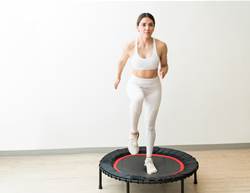Did you know that your pelvic floor is essential in holding you together, especially down there? Let us explain. Made up of layers or muscles and other tissues, your floor reaches from the tailbone to your pubic bone. It houses the bladder, uterus and colon and also plays an important role in sexual function. In light of this, it is easy to see how it is important for these muscles to be strong and functioning well.
According to Jen Dugard, a pelvic floor expert and founder of MumSafe, pelvic floor health is often a topic not spoken about enough. Education is vital to understand what is normal and what is not and allows you to recognize warning signs if something is wrong and get help.
You might need to relax it
“Some woman can suffer from a hypertonic or overactive pelvic floor” says Jen. This is when the muscles in your pelvic floor becomes very tense with an inability to relax them. Common health problems associated with this condition can include “re-occurring UTI’s, painful intercourse and glute or lower back pain” she continues. We often see this in women who train a lot and do a lot of core work suffer from this. Holding in your bladder and/or bowl movements can also cause tension to develop in pelvic floor muscles, according to the Continence Foundation of Australia. And if you suffered birth trauma you may be at a higher risk as the pain and scarring can lead to more tension.
You could be pushing it out
“Research suggests that up to 60% of women bare down or push out on their pelvic floor instead of drawing it up, which is the correct movement”, says Jen. This also often happens when you’re not doing pelvic exercises correctly. “You might be thinking that you’re strengthening your pelvic floor, but you could actually be weakening them”, she says. Make sure you fully understand what you need to do during an exercise and ask for help if you’re unsure.
It may not hurt…
But that doesn’t mean it’s all okay. Jen states that, “after babies your pelvic floor muscles may become stretched or weaker and may lead to incontinence. This is more common than you think and not something that is untreatable and that you simply have to live with”. Unfortunately, many women do end up living with it and over the long term doing more harm with exercise because it doesn’t hurt when you exercise. If left untreated it may become worse leading to more concerning issues such as a prolapse which is preventable.
What to do if you’re worried?
The most effective way to treat any concerns regarding your pelvic floor, regardless if you’ve had a baby or not, is to understand your unique concerns and needs. Jen advises seeing a women’s health physiotherapist especially if your pregnant or postpartum. They have expertise and knowledge that can make a world of difference.
Here are three small, yet effective ways Jen advises you can do to help strengthen your pelvic floor (without causing harm) :
1. Find a cue that works for you
Finding a muscle that you cannot see or feel externally can be tricky so working out what cues work best for you is super important. Here are two visual cues:
- Imagine a flower gently closing (contract) and releasing (relax).
- Imagine you are gently sucking a blueberry up a straw…then release.
2. Diaphragmatic breathing
Breathing may sound counter-intuitive, but if you are not breathing well, you may not be activating your pelvic floor well either. The biomechanics of your body mean that your pelvic floor should activate as you breathe out. Take some time out to lie on the ground or sit in a comfortable position; take a few deep breaths in, filling up both your chest and your stomach and as you breathe out, think about gently drawing in and lifting your front passage (vagina).
3. Incorporate your pelvic floor exercises with glute work
Your pelvic floor is linked to your glutes and adductors. When you squeeze your glutes to gently raise your hips off the floor in a hip raise you will find your pelvic floor activates too.









